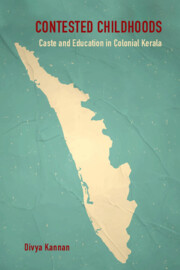Conclusion
Published online by Cambridge University Press: 28 November 2024
Summary
By 1957, education had truly become a political battleground in the state of Kerala. The newly elected government, led by the Communist Party of India, announced the agrarian relations and education Bills, aimed at keeping its promise of redistributing resources and regulating private educational institutions, against which there was mounting criticism of financial irregularities and biases. However, these private grant-in-aid institutions run by Catholics and Nairs, among other communities, occupied a crucial position in the promotion of school and collegiate education, and the government's attempts to restrict the authority of private managers received an unprecedented backlash. With the shift from a period when missionary and private manager-led schools looked towards the government for financial assistance to a stage where they waged mass agitations to topple the first democratically elected government for increasing regulatory norms, the relationship between the state and private actors in education had come full circle. Despite intense strife and the demonstration of the political clout enjoyed by religious, upper-caste communities through their educational networks, the underlying consensus on formal schooling as an anchor for modern childhood prevailed.
Around the same time, in 1956, the Education Department under the aegis of the director of public instruction, C. S. Venkateswaran, introduced the Kerala School Kalolsavam (Kerala State School Youth Festival), aimed at encouraging school-going children between the ages of twelve and seventeen years to showcase their artistic talents and drive to innovate and promote traditional and new art forms. The immense popularity of the festival, touted as one of the largest cultural events in Asia, has accumulated praise and criticism over the past few decades, as it also demonstrates severe competition among pupils to the detriment of their mental and physical health and pressure on children from their parents, music and dance teachers, and district-level authorities, all competing for prestigious titles and media coverage. The overwhelming attention paid to the young participants of these festivals is rather representative of evolving notions of Malayali children as ‘competing commodities’ in the wider market while they are also expected to be consumers and mediators of local cultural practices.
- Type
- Chapter
- Information
- Contested ChildhoodsCaste and Education in Colonial Kerala, pp. 264 - 268Publisher: Cambridge University PressPrint publication year: 2025

